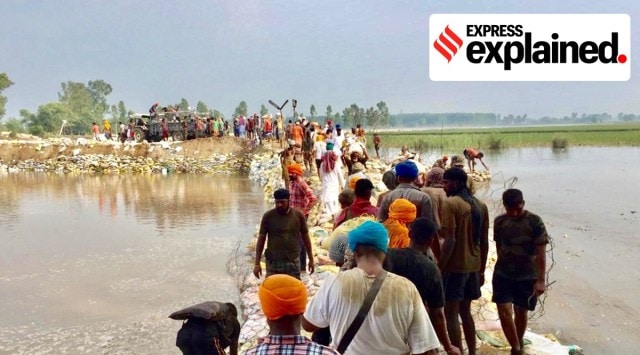As Punjab faces floods, can canalisation of rivers be a solution?
Apart from local rains, water flows down through the rivers when states such as Himachal Pradesh see rainfall. The overspill from the large dams requires better management, necessitating additional storage facilities to release water downstream gradually.
 Canalisation involves regulating the flow of water, by directing river water into specific channels, utilising mini dams for regulation, establishing interconnections between canal systems and rivers, and fortifying earthen embankments in times of need. (Express Photo by Anju Chaba)
Canalisation involves regulating the flow of water, by directing river water into specific channels, utilising mini dams for regulation, establishing interconnections between canal systems and rivers, and fortifying earthen embankments in times of need. (Express Photo by Anju Chaba) In the last month, Punjab has been struck by two major instances of flooding. The initial deluge was a result of intense rainfall across Punjab, Haryana, and Himachal Pradesh, leading to a massive influx of water into Punjab’s rivers.
The second case of flooding was caused by the heavy rainfall in Himachal Pradesh. This inundated major dams, leading to the release of water downstream and posing a significant risk to Punjab during the rainy season.
The rivers and rivulets of Punjab
Punjab is traversed by three perennial rivers — Sutlej, Beas, and Ravi — alongside two rivulets, the eastern (Chitti) and western (Holy) Beins.
Moreover, two non-perennial monsoon rivers, Ghaggar and Chaki rivers, along with 16 major seasonal streams in districts like Hoshiarpur, Ropar, Mohali, and Nawanshahr contribute to the state’s water network. Minor seasonal rivulets, called choes and khads also, contribute to the water flow during the monsoon season.
Experts say that these water sources, particularly perennial and non-perennial rivers originating from Himachal and Jammu & Kashmir, bring substantial monsoon water to Punjab. When dams here are filled to capacity and water is released, Punjab is at risk of downstream flooding even without heavy local rainfall.
Experts suggest effective regulation of rivers and water sources is required here and canalisation can be one method of achieving this.
How does canalisation of rivers work?
Canalisation involves regulating or diverting the flow of water from a water source, such as a river. This can include directing river water into specific channels, utilising mini dams for regulation, establishing interconnections between canal systems and rivers, and fortifying earthen embankments in times of need.
What is the current state of canalisation in Punjab?
The perennial rivers have significant dams, such as the Bhakra Nangal Dam on the Sutlej, Pong Dam on the Beas, and Ranjit Sagar or Thien Dam on the Ravi. There are also Dhussi Bandhs — earthen embankments — on all these big rivers.
However, the inherent weaknesses in Dhussi Bandhs make them susceptible to breaches during even modest increases in river flows. A multitude of small earthen dams with limited capacity exists in districts like Hoshiarpur. But many local rivulets, rainwater drains, and Nullhas lack proper canalisation, exacerbating flood risks.
The overspill from the large dams requires better management, necessitating the creation of additional storage facilities to release water downstream gradually.
How canalisation can play a role in flood prevention
Both the recent floods in Punjab resulted from the overflowing of main rivers and local waterways. The first instances of flooding, on July 9 and July 10, were driven by heavy regional rainfall, causing unregulated rivers, Nadis, rivulets, Nullahs, etc. to overflow into the Sutlej and Ghaggar rivers.
The second flood, beginning August 15, saw minimal local rain. Instead, incessant rainfall in Himachal filled the Bhakra Nangal and Pong dams to capacity, forcing the release of heavy water downstream into Punjab. Here, undertaking canalisation would help manage both local rain and dam releases.
A senior officer in the drainage wing of the Punjab Water Resources Department said long-term canalisation strategies could be a possible solution, along with the yearly strengthening of Dhussi Bandhs, extending them up to 30 to 40 feet.
In a nutshell, the officer said, Punjab’s vulnerability to floods demands that canalisation efforts should be taken up to avert future disasters.
- 01
- 02
- 03
- 04
- 05






































